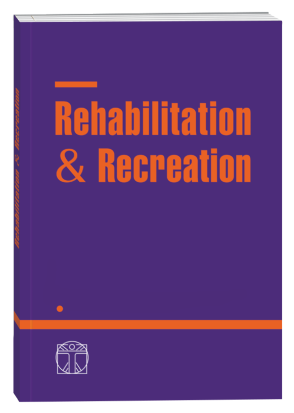TRAINING LOADS OF PLAYERS OF THE NATIONAL JUNIOR NATIONAL TEAM IN SWIMMING
DOI:
https://doi.org/10.32782/2522-1795.2022.10.14Keywords:
training loads, direct boot preparationAbstract
In the above work, an attempt was made to determine the training loads of the players from the national team of juniors in swimming and their impact on the final result in the main competitions. If you want to effectively manage the training process, you should rely on proven ways of influencing the player. Here, the correct selection of training loads is very important, and the search for examples of their effective impact provides valuable training information and application conclusions. The study used research methods in the form of a comparative analysis of training loads in the macrocycle from September to December 2020. Need-data 6 juniors of the Polish national team in swimming were examined, whose influence of training loads on high results in the national rank. 3 girls and 3 boys were examined. All players were 16 years of age. The whole group followed one training program. Checking the data obtained from the analysis made it possible to show information on the amount of training loads in the water of the players in which swimmers were subjected to control starts in September in Wrocław, swimming about 8 km on one training unit, in October 160 km, having a control start in Lublin, swimming about 7 km. In the last 14 days before the main competition, the riders swam about 5.5 km in the first week and 3.6 km in the second. The swimmers followed the same training program. The planned training loads brought the planned results during the Polish Championships, where the players improved their life results so far, winning gold and silver medals. One of the ways to achieve mastery is to find the optimal relationships between the implementation of training loads and changes in the level of the competitor’s training.
References
Bartkowiak E. Pływanie sportowe. Warszawa, 1972.
Fidelus K. Przewodnik do ćwiczeń z teorii sportu. Warszawa, 1970.
Kashuba V., Andrieieva O., Hakman A., Grygus I., Smoleńska O., Ostrowska M., Napierała M., Hagner-Derengowska M., Muszkieta R., & Zukow W. (2021). Impact of Aquafitness Training on Physical Condition of Early Adulthood Women. Teorìâ Ta Metodika Fìzičnogo Vihovannâ, 21(2), 152–157. https://doi.org/10.17309/tmfv.2021.2.08.
Kosmol A., Słomiński P., Hűbner-Woźniak E., Nowicka K. Wykorzystanie wyników badań diagnostycznych i analizy obciążeń w kierowaniu treningiem (na przykładzie pływania), [w:] Śledziewski D., Karwacki A. (red.) Szkolenie uzdolnionej sportowo młodzieży w polskim systemie edukacyjnym, PTNKF. Warszawa, 2003.
Kreft P., Skalski D., Pęczak-Graczyk A. I., Makar P. Obciążenia treningowe w bezpośrednim przygotowaniu startowym w pływaniu. Gdańsk, 2021.
Makar P. Wpływ obciążeń treningowych na zmienność indywidualnej techniki w rocznym cyklu szkolenia 16–18 letnich pływaków AZSAWFIS w Gdańsku. Gdańsk, 2006.
Mleczko E., Żarek J. Wykorzystanie sport-testera i mikrokomputerów w pomiarach obciążeń treningowych, Sport Wyczynowy, nr 9–10. Warszaw, 1991.
Naglak Z. Pomiar obciążeń treningowych. Wrocław, 1977.
Perkowski K., Śledziewski D. Metodyczne podstawy treningu sportowego. Warszawa, 1998.
Płatonow W. N. Trening wyczynowy w pływaniu. Struktura i program. Warszawa, 1997.
Siewierski M., Słomiński P., Białecki R. Kontrola stanu wytrenowania a dobór obciążeń treningowych. Przyczynek do optymalizacji obciążeń treningowych na przykładzie kadry narodowej i olimpijskiej w pływaniu, Kultura Fizyczna. Warszawa,2006.
Słomiński P. Efektywność procesu treningu mistrzyni i mistrza świata i Europy w pływaniu w cyklu olimpijskim do Igrzysk Olimpijskich w Pekinie (2008), Rozprawa doktorska, AWF Warszawa. Warszawa, 2016.
Sozański H. Kierunki optymalizacji obciążeń treningowych. Warszawa, 1992.
Sozański H. Kontrola treningu, jego efektów adaptacyjnych i walki sportowej, Sport Wyczynowy, nr 7. Warszawa, 1996.
Sozański H., Śledziewski D. Obciążenia treningowe dokumentowanie i opracowywanie danych. Warszawa, 1995.
Ulatowski T. Teoria i metodyka sportu, SiT. Warszawa, 1998.
Ważny Z. Rozważania na temat metodyki treningu sportowego, Sport Wyczynowy. Warszawa, 2004.
Ważny Z. Struktura obciążenia treningowego oraz metody jej realizacji i analizy. Wrocław, 1982.
Wojcieszak I. Wydolnościowe testy specjalne, Wdrożenia. Warszawa, 1985.
Downloads
Published
How to Cite
Issue
Section
License

This work is licensed under a Creative Commons Attribution-NonCommercial-NoDerivatives 4.0 International License.











